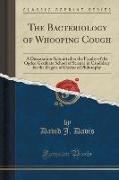The Bacteriology of Whooping Cough
BücherAngebote / Angebote:
Excerpt from The Bacteriology of Whooping Cough: A Dissertation Submitted to the Faculty of the Ogden Graduate School of Science in Candidacy for the Degree of Doctor of Philosophy
The etiology of whooping-cough has not as yet been determined, notwithstanding the large number of investigations upon this subject. The disease has many serious aspects, and the problem of its etiology surely deserves to be ranked among the most important of the still numerous problems concerning infectious diseases that so far have not been solved. Like many other infectious diseases, the therapeutics of whooping-cough is in a most unsatisfactory condition, and it is likely to remain so, at least until the etiology is determined. No specific is known, and while some drugs may mitigate the symptoms slightly, none has any appreciable effect upon the general course of the disease. As regards its prevalence, it occupies a position in the first ranks of the infectious diseases of children, probably being equaled only by measles in this respect. While in strong, healthy, and older children the disease may not be considered very serious, however, owing to its prolonged course, especially in the winter months, with an abundance of serious complications and sequelæ, it must be looked upon, as the high rate of mortality abundantly proves, as one of the most dreaded diseases for the young infants and the more delicate children.
Reasons for assuming ii an infectious disease. - There can be no doubt that whooping-cough is an infectious, transmissible disease. Several convincing reasons may be given for this. Transmission of the disease certainly occurs by contact between children, and Baginsky states positively that he has observed transmission by a third person. There is no doubt that the virus adheres to rooms and fomites. The frequent epidemic character of the disease, and its endemic character in cities, indicate its infectious nature. Again, the disease has a fairly definite period of incubation. There is some difference of opinion as to the length of this period, but most observers agree that it is from 7 to 14 days. Immunity is as a rule conferred by the attack. Indicative of its infectious nature is also the relatively high leucocytosis, which varies from 12, 000 to 45, 000, the increase in the mononuclears being particularly characteristic. Not only does the clinical course of the disease indicate an infectious catarrhal condition of the upper respiratory passages, but the pathologic anatomy substantiates such a conclusion.
About the Publisher
Forgotten Books publishes hundreds of thousands of rare and classic books. Find more at www.forgottenbooks.com
This book is a reproduction of an important historical work. Forgotten Books uses state-of-the-art technology to digitally reconstruct the work, preserving the original format whilst repairing imperfections present in the aged copy. In rare cases, an imperfection in the original, such as a blemish or missing page, may be replicated in our edition. We do, however, repair the vast majority of imperfections successfully, any imperfections that remain are intentionally left to preserve the state of such historical works.
Folgt in ca. 5 Arbeitstagen




